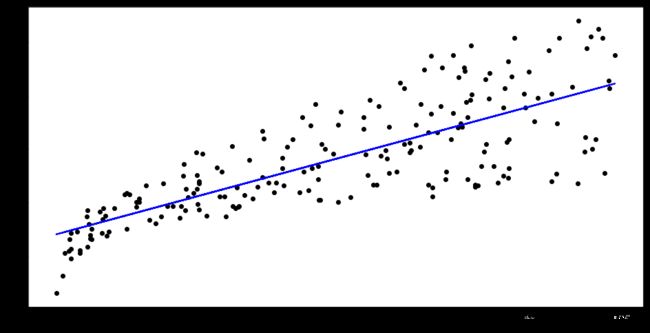贪心科技机器学习训练营(一)
来源:贪心学院,https://www.zhihu.com/people/tan-xin-xue-yuan/activities
笔者,最近参加的贪心科技的机器学习训练营。。。。。。。。
学习本是一个反复的过程。
竟然要我写笔记交作业,还要写在知乎。。。。。。。。
我知乎没文章啊啊啊啊
我赶紧找下之前写的博文
从简单的一元回归分析入门机器学习
用多元线性回归分析问题
机器学习概念
线性回归实例
机器学习入门之线性回归
你所在的公司在电视上做产品广告, 收集到了电视广告投入x(以百万为单位)与产品销售量y(以亿为单位)的数据. 你作为公司的数据科学家, 希望通过分析这些数据, 了解电视广告投入x(以百万为单位)与产品销售量y的关系.
假设x与y的之间的关系是线性的, 也就是说 y = ax + b. 通过线性回归(Linear Regression), 我们就可以得知 a 和 b 的值. 于是我们在未来做规划的时候, 通过电视广告投入x, 就可以预测产品销售量y, 从而可以提前做好生产和物流, 仓储的规划. 为客户提供更好的服务.
import pandas as pd
import numpy as np
import matplotlib.pyplot as plt
from sklearn.linear_model import LinearRegression
data = pd.read_csv("data/Advertising.csv")
data.head()
| TV | sales | |
|---|---|---|
| 0 | 230.1 | 22.1 |
| 1 | 44.5 | 10.4 |
| 2 | 17.2 | 9.3 |
| 3 | 151.5 | 18.5 |
| 4 | 180.8 | 12.9 |
data.columns
Index(['TV', 'sales'], dtype='object')
通过数据可视化分析数据
plt.figure(figsize=(16, 8))
plt.scatter(data['TV'], data['sales'], c ='black')
plt.xlabel("Money spent on TV ads")
plt.ylabel("Sales")
plt.show()
训练线性回归模型
# 将pandas的Series变成numpy的ndarray
X = data['TV'].values.reshape(-1,1)
y = data['sales'].values.reshape(-1,1)
reg = LinearRegression()
reg.fit(X, y)
LinearRegression(copy_X=True, fit_intercept=True, n_jobs=None,
normalize=False)
print('a = {:.5}'.format(reg.coef_[0][0]))
print('b = {:.5}'.format(reg.intercept_[0]))
print("线性模型为: Y = {:.5}X + {:.5} ".format(reg.coef_[0][0], reg.intercept_[0]))
a = 0.047537
b = 7.0326
线性模型为: Y = 0.047537X + 7.0326
可视化训练好的线性回归模型
predictions = reg.predict(X)
plt.figure(figsize=(16, 8))
plt.scatter(data['TV'], data['sales'], c ='black')
plt.plot(data['TV'], predictions,c ='blue', linewidth=2)
plt.xlabel("Money spent on TV ads")
plt.ylabel("Sales")
plt.show()
[外链图片转存失败(img-JgGwDudv-1562917224938)(output_11_0.png)]
假设公司希望在下一个季度投一亿元的电视广告, 那么预期的产品销量会是多少呢
predictions = reg.predict([[100])
print('投入一亿元的电视广告, 预计的销售量为{:.5}亿'.format( predictions[0][0]) )
投入一亿元的电视广告, 预计的销售量为11.786亿
# 练习
df = pd.read_csv('exercise/height.vs.temperature.csv')
df.head()
| height | temperature | |
|---|---|---|
| 0 | 0.0 | 12.834044 |
| 1 | 500.0 | 10.190649 |
| 2 | 1000.0 | 5.500229 |
| 3 | 1500.0 | 2.854665 |
| 4 | 2000.0 | -0.706488 |
from sklearn.linear_model import LinearRegression
x = df['height'].values.reshape(-1, 1)
y = df['temperature'].values.reshape(-1, 1)
model= LinearRegression()
model.fit(x,y)
LinearRegression(copy_X=True, fit_intercept=True, n_jobs=None,
normalize=False)
# 查看斜率和截距
print(model.coef_)
print(model.intercept_)
[[-0.00656953]]
[12.71850742]
# 查看数据
plt.figure(figsize=(16, 8))
plt.scatter(df['height'], df['temperature'], c ='black')
plt.xlabel("heigth")
plt.ylabel("temperature")
plt.plot(df['height'],model.predict(df['height'].values.reshape(-1,1)))
plt.show()


